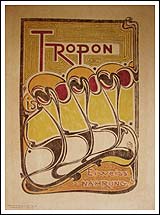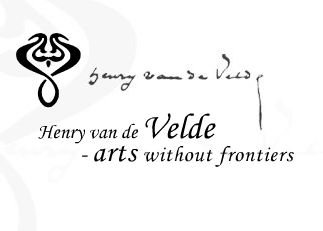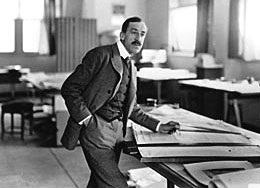The commotion surrounding van de Velde's designs was heard as far afield as Germany where a delegation from Dresden, which was looking for works to be included in the 1897 "Dresdner Kunstgewerbe Austellung" and decided to visit the "L' Art Nouveau" in Paris. They immediately invited Henry van de Velde to exhibit his four Bing interiors in Dresden, toghether with a new design entitled "Ruheraum". In contrast to the Paris exhibition, van de Velde' s work was greeted with general enthusiasm.
| |
 |
| |
Tropon Poster, 1898 |
Dresden 1897 signifies the starting point of Henry van de Velde's career in Germany. His German period constitutes without any doubt the absolute high point of his work, as regards both quantity and quality. Influential figures in van de Velde's first German commissions include Julius Meier Graefe (art critic and publisher of the magazine -'Decorative Kunst' (1897) and L' Art décoratif (1898), Harry Graf Kessler and Baron Eberhard von Bodenhausen, woth wealthy art-lovers who were good friends and members of the editorial staff of the magazine 'PAN'. In addition to the space they gave to van de Velde in their respective magazines (he published, for example, a controversial article in PAN in 1897 in "Entwurf und Bau moderner Möbel" and the first issue of "L' Art décoratif" (October 1898) was devoted entirely to his work) They were also his first German patrons: van Bodenhausen commissioned him to repare the advertising material for his company "TROPON" and to design his own furniture, Harry Kessler commissioned him to design furniture for his own house in Berlin and Meier Graefe the interior design of his "La Maison Moderne" in Paris. In the meantime von Bodenhausen had also raised the capital to set up a 'société van de Velde' in Ixelles, Brussels where Henry van de Velde could organise his own production of his design for furniture. Owing to the increase in orders from Germany (including shop layouts for the Habena company of Berlin and work for the folkwang museum in Hagen) the workshops in Ixelles soon encountered organisational and economic problems (customs, transport) and in the winter of 1900-1901 it moved to Berlin. In October 1900 van de Velde decided to move to Berlin himself, taking his family with him. In the meantime he had produced designs for the Krefeld silk industry wich was having to counter severe competition from Lyon. They hoped to capture the progressive section of the market by giving their products a new aesthetic style. In Berlin van de Velde noticed a great contrast between the official art and the progressive new trends in the visual arts, literature and music. He was disappointed by the lack of interest shown by industrial circles and above all by his collaboration with the Berlin company, Hirschwald, for his furniture designs. During his Berlin period van de Velde did however produce one of his most important works: the alternations to the Folkwang Museum in Hagen (1900-1902). Although van de Velde was only appointed as the designer by Karl Ernst Osthaus on completion of the structural work he was nonetheless able to instill the building with a greater plasticity. He himself commented: "I attempted to draw profiles which would match the beams and metal skeletal structure of the building. The problem I had to solve seemed to be that which is found in nature itself, that is, the relationship between the skeleton and the flesh. In this respect the problem of covering a metal skeleton seemed both healthy and normal". The sobriety of style as we know it from the Bloemenwerf furniture was slowly abandoned after 1896 (the first commission from Bing). More and more luxurious materials were used and the sinusoidal curve began to make its appearance.
This resulted in a total unity in the furniture with an indistinguishable fusion of construction and ornamentation. The furniture is characterised by a play of active dynamic lines wich give unity to the whole. This achieves a coherence of the constructional concept and the ornamentation. The ornamentation does not function as decoration in itself but has an almost didactical role as a functional element in space. There are two ways of obtaining a symphonic harmony of these two possibilities: either by eliminating al the decorative elements in order to retain solely the pure form of the furniture (as van de Velde did in his early works, and which he was to repeat in a perhaps even more pure form in the later stages of his work), or by achieving a more subtle style wich accentuates the essential constructive elements. In the period 1897-1905 van de Velde opted for the latter solution: a desk is above all and in all a work table, and all elements of the furniture serve his function. The same also applies, for example, to seating where the curved armrests are an allmost irresistible temptation to lean back and relax. His furniture from this period like an invitation to use the object in question and represent a reconciliation between functionalism and expressive styling.
There is a balanced unity between construction and ornamentation, in which it must however be clearly stated that the structuring form takes precedence over decorative effect.
In the meantime Henry van de Velde was invited by the Grand Duke Wilhelm Ernst, who, in 1901, succeeded to the throne of the Grand Duchy of Sachsen-Weimar. At the time the industry of the Grand Duchy was experiencing economic difficulties owing to the competition from better-equipped and more favourably situated German companies. In Weimar van de Velde was commissioned to instill new life into the declining industries and met with succes with the Burgel pottery, the Tannroda basket weaving plant (whose produce included woven furniture) and the Rhula pipe factory. His responsibilities also extended to conducting the "Kunstgewerbliche Seminar" where he trained artists in preparation for their activities in arts and crafts workshops or in the art industry. In this way van de Velde attempted to bring toghether artists, craftsmen and manufacturers: "I had already achieved such a cooperation six years before the founding of the Werkbund and twenty years before the Bauhaus".
The Weimar period was a mixture of high points and critical situations, typified by violent criticism or absolute rejection of his work. In 1902 for example the German Kaiser Wilhelm II refused to visit a room furnished by van de Velde at the "Düsseldorfer Industrieausstellung". The exhibition room (as a prototype for a planned museum in Weimar) which he presented at the "Dresdner Kunstgewerbeaustellung" was strongly criticised in the press. The theatre project for Louis Dumont was rejected by the official Weimar court theatre. His designs for the Paris "Théatre des Champs-Elysées" (1910) were not produced, although they were partly incorporated in the plans of the French architect Perret. More succesfull was the building of the Villa Esche in Chemnitz (1902), the Villa Leuring in Schevingen (the Nederlands) (1902), his own house "Hohe Pappeln" (1902) (in Ehringsdorf, Weimar) and "Kunstschule" (1904) and the "Kunstgewerbeschule" (1906-1907).
An absolute high point was, however, the "Hohenhof" house commissioned by K.E. Osthaus in a suburb of Hagen (1906). Here van de Velde succeeded in giving the immense villa an orderly concept of the space. The harmony with the wooded setting was obtained by a broad rounding of the concerns, the use of natural stone and a diversification of roofing. Osthaus later described the concept as follows: "It becomes clear from this work that van de Velde bases his designs more on the plastic modelling of the body than the concavity of space. This is the clue to his affinity with the Greeks and his aversion to the designs of the Renaissance. The Hohenhof bears witness to his endeavours to grasp the cube as such, particulary in the rounding off of the corners of the upper storey on the east façade, in the bulging of the bay windows in the bathroom, and the high point of the roof. Even the design of the chimney in the outbuilding is a confirmation of his plastic sensation. Conversely, none of the courtyards and gardens show any leaning towards the formation of space. The animation of the material is sought not in the breathing tension between body and space but in the dynamic expression of the mass."
After the unfortunate experiences of the Louise Dumont theatre and the Paris Champs-Elysées theatre, van de Velde was, however, to succeed in seeing one of his designs for a theatre realised. On the banks of the Rhine he designed a theatre for the German Werkbund. In the face of initial opposition to his project (owing to his foreign nationality), he finaly received the commission in February 1914 thanks to the support of the Mayor of the city of Cologne, Conrad Adenauer. Five months later the theatre opened: it was not only remarkable for the exceptional plasticity of the façade but also caused quite a sensation owing to the technical innovations: a hall in the shape of an amphitheatre, an independent proscenium, a rounded background and a stage in three sections.
The Werkbund exhibition was also to be the platform for a vigorous exchange of ideas: at the annual meeting of the Werkbund in 1914 this led to heated discussions between van de Velde and Muthesius on the relationship of art and industry, or more specifically: the relationship between the artist and the standarisation. The German Werkbund was set up in 1907 in Munich with the object of bringing toghether artists and industrialists with a view to achieving a harmonious development of the technical and the aesthetic of German "Arbeit".



